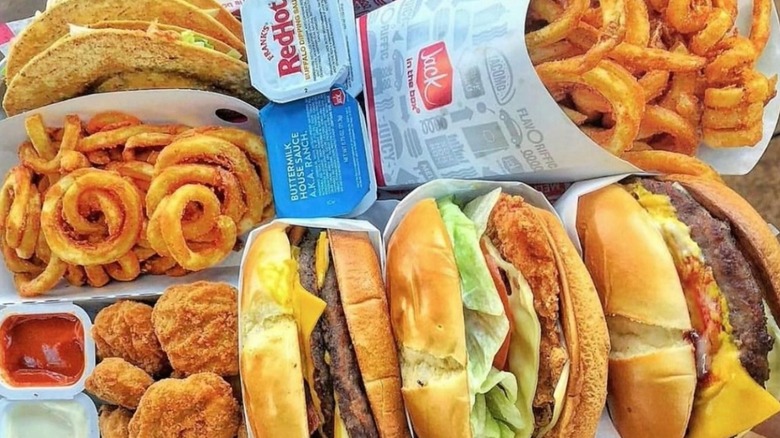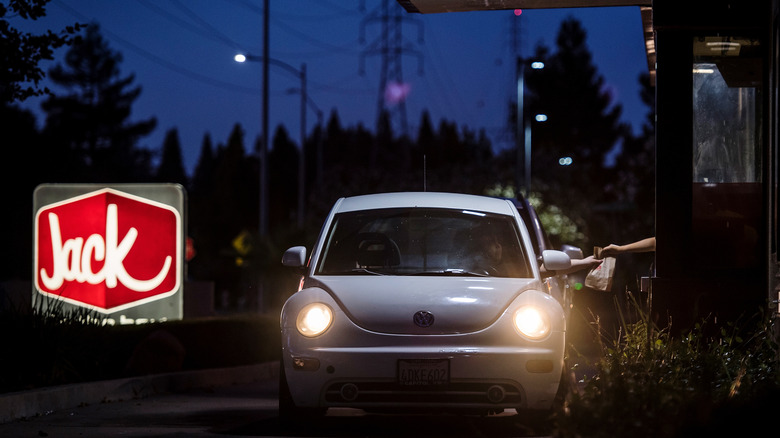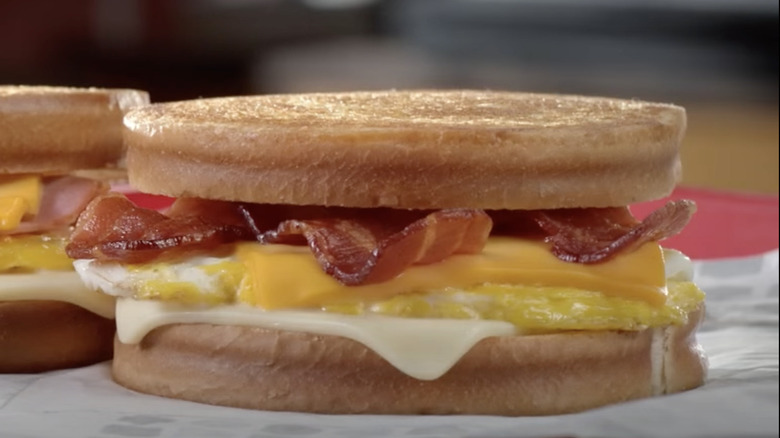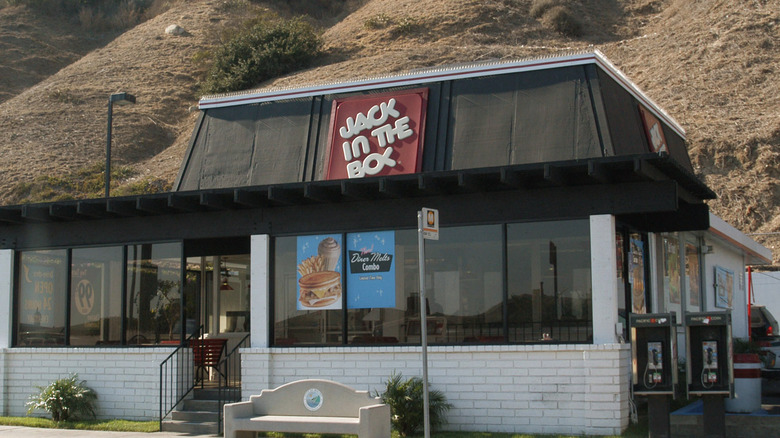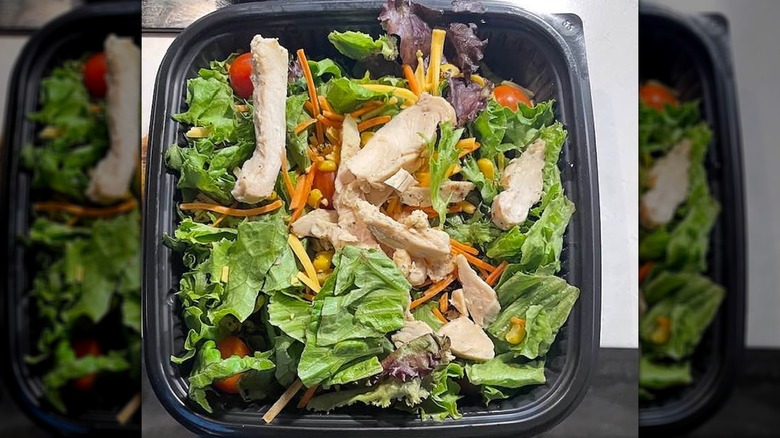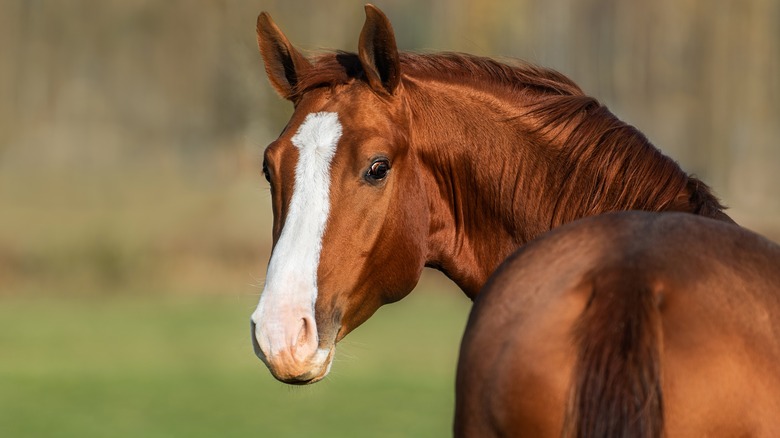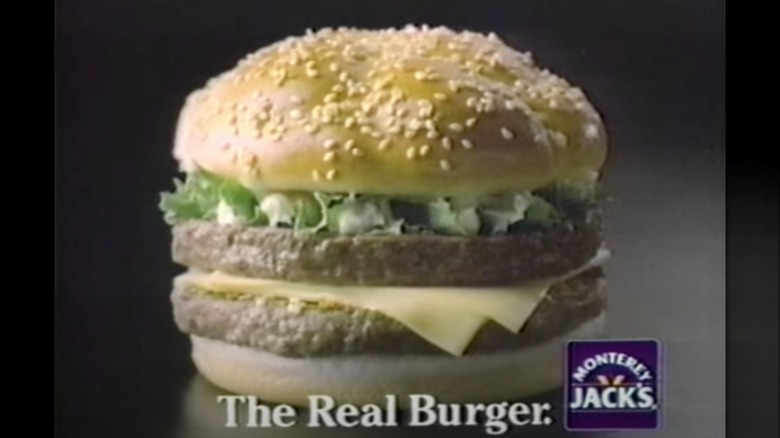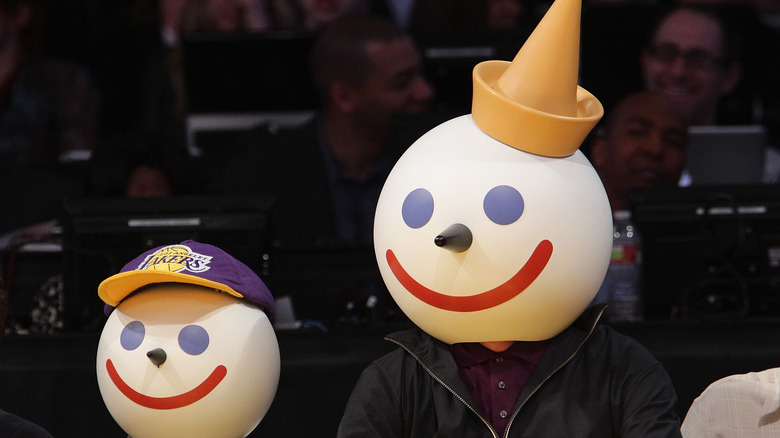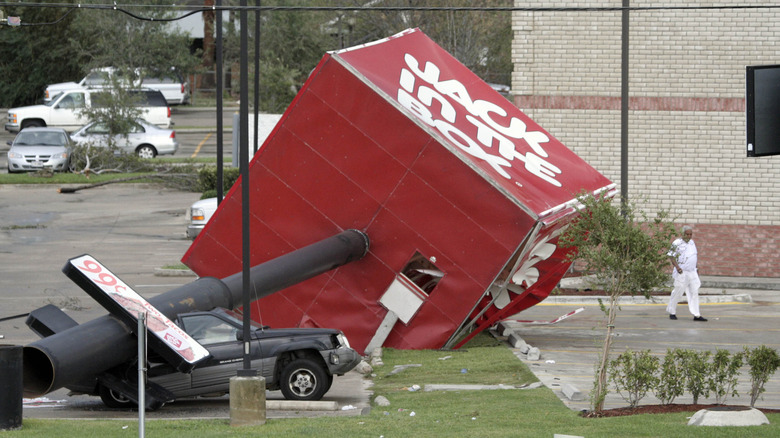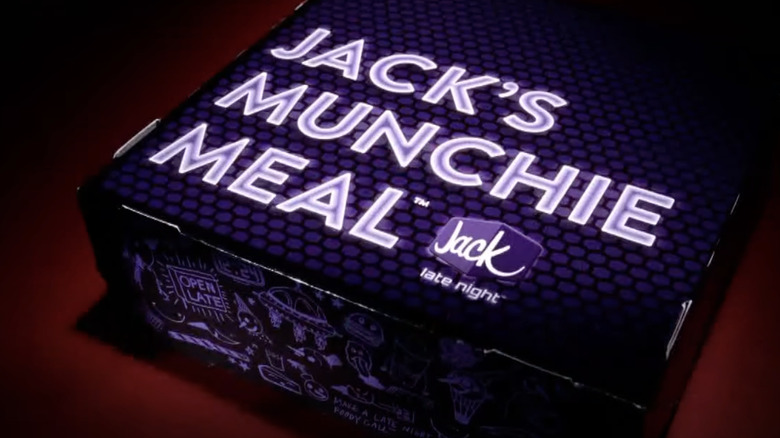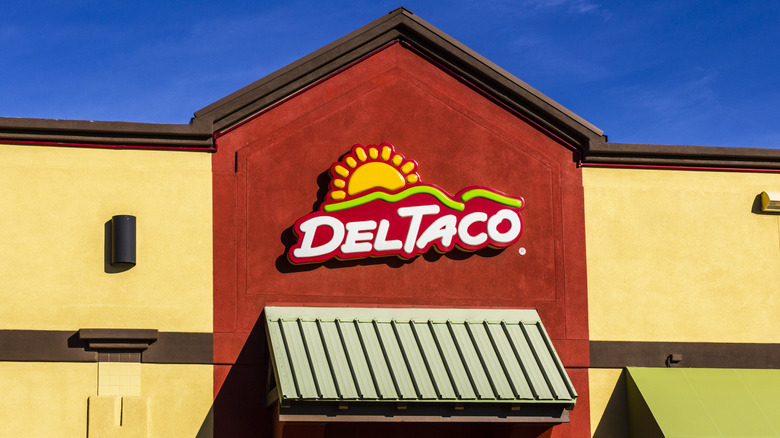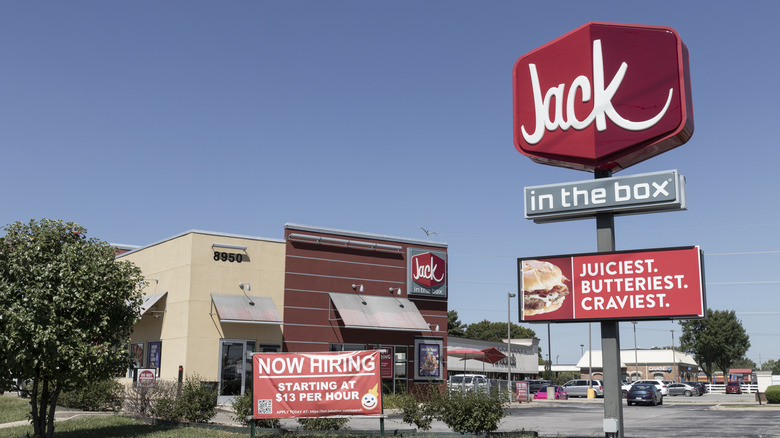The Rise, Fall, And Resurgence Of Jack In The Box
More than six decades old at this point, Jack in the Box has survived a tumultuous and competitive fast-food landscape that it helped create. Emerging from a small San Diego drive-in chain in the 1940s, Jack in the Box evolved into one of the most visible and lucrative of the fast-food brands. Much of that growth can be attributed to innovation. Never an institution to rest on its laurels, Jack in the Box seems to always be changing something, whether it's adopting new technology, trying out a quirky advertising campaign, or developing its menu to include a wider variety of offerings than its competitors. The chain is just about the only place where on-the-go diners can order tacos, egg rolls, and churros to accompany their burgers, fries, and shakes.
On the other hand, Jack in the Box's willingness to try almost anything in terms of menu items, streamlining practices, business concepts, and marketing ideas, has also led to major missteps, unmitigated disaster, and full-on tragedy. Here's the full story of Jack in the Box — the highs, the lows, and every novel chapter in between.
Jack in the Box helped popularize the drive-through
After working as a traveling milkshake mixer salesman, San Diego-based entrepreneur Robert Oscar Peterson opened a drive-in restaurant in 1941 called Topsy's. Following a stint in naval intelligence during World War II, Peterson returned home, changed the name of Topsy's to Oscar's, and installed a novel device that made the hamburger stand even more profitable.
He licensed the rights to an intercom system from George Manos, who had installed the technology at a Chatterbox drive-in in Alaska. Diners pulled up to a lane and spoke into a two-way communication device connected to the kitchen inside. Because customers could take their food and leave, it allowed for rapid turnover and high sales volume — and so the fast food drive-through was born. In 1951, Peterson converted an Oscar's Drive-In into the first Jack in the Box, incorporating clown imagery and placing the drive-through speaker inside an oversized clown head.
It was an early pioneer in fast food breakfast
It took a few decades for the United States' top purveyors of burgers and fries to establish themselves as attractive options for lunch and dinner before they even attempted to revolutionize the way Americans ate breakfast. The Egg McMuffin hit the national McDonald's menu in 1976, less than five years after it debuted in test markets. Around the same time that McDonald's was making inroads into breakfast, Jack in the Box was too.
In 1969, two years before the Egg McMuffin arrived, individual Jack in the Box restaurants tested earlier opening hours to sell a small breakfast menu, anchored by two items: the Breakfast Jack (eggs, ham, and cheese on a hamburger bun) and an Eggs Benedict-inspired sandwich. The two items were the first chain fast-food breakfast sandwiches in America and sold well. In fact, in 1976, Jack in the Box expanded its breakfast menu to include omelets. By the 21st century, the chain's best-selling menu sector was breakfast, which it sells all day long, unlike the competition.
Jack in the Box expanded so quickly in the '60s but faltered in the '70s
In the 1960s under founder Robert Oscar Peterson, Jack in the Box, rapidly expanded throughout Southern California. It grew to 24 outlets by 1961 and to 182 just five years later. By the end of the decade, Jack in the Box was 870 units strong. At this point of robust and lucrative growth, the multi-tiered food-based corporation Ralston Purina purchased the entirety of the Jack in the Box parent company, turned it into a subsidiary, and made efforts to convert the restaurant from a west-coast favorite into a nationally known fast-food competitor.
Hundreds more Jack in the Box outlets opened throughout the Midwest and into the Northeast. But those Jack in the Boxes didn't prove to be especially popular or as profitable. Shortly after opening its 1,000th restaurant in 1980, Jack in the Box announced plans to close 225 financially underperforming locations in the east. It reallocated resources spent on keeping those money-losing restaurants alive into opening dozens of new locations back west.
More than 40 years later, Jack in the Box has stuck to that plan. About 43% of its restaurants are situated in California, with most of the rest in Oregon, Washington, Arizona, and Texas. It's not a major player in the east, with only a few outposts in the Carolinas and a single restaurant in New Jersey.
Jack in the Box underwent a massive menu overhaul in the 1980s
Along with the early 1980s shutdown of 200 restaurants, Jack in the Box approached the new decade with a series of aggressive business and culinary moves. It alerted the public of changes to come with a TV commercial in which restaurant employees use dynamite to blow up one of the clown heads that adorned the chain's drive-through speaker boxes in the 1970s. "The food is better at the Box," a newly adopted slogan intoned.
Realizing it couldn't "out-McDonald's McDonald's," as chairman Jack Goodall told the Los Angeles Times, the chain redecorated its restaurants to downplay the clown imagery and brought in new items to attract a wealthier, more mature clientele. Throughout the '80s Jack in the Box introduced a ham and cheese sandwich, the fajita pita (made with steak), and fast food's first to-go salad. By 1987, Jack in the Box boasted an extensive, 40-item menu, and half of it had made its debut within the past five years.
The plan to steer clear of the McDonald's-Burger King fight to dominate the burger industry worked. By reinventing itself as a western-U.S. chain in pursuit of a specific, niche customer base, Jack in the Box was able to open 400 new stores in the late 1980s. In its core markets of Los Angeles, San Diego, Dallas, and Phoenix, it ranked as the #1 or #2 fast-food chain.
The chain accidentally sold horse meat
The notion of which animals are acceptable for consumption varies across cultures and nations. In the United States, for example, eating horse or kangaroo isn't widely practiced or accepted. That's only part of the reason why Jack in the Box sustained some controversy in the early 1980s: The chain likely served ground horse in its American stores, but unknowingly.
At the time, imported beef comprised 7% of the American beef supply, and Jack in the Box got some of its meat from a company called Profreeze, which sourced from Australia. In the summer of 1981, Profreeze found that some of the Australian product designed for distribution to Jack in the Box wasn't just from cows — it was partially made up of horse meat, too. Back in Australia, inspectors found that more shipments of ground beef intended for the U.S. were also not 100% beef, but contained some kangaroo meat.
It all probably meant that ground horse and minced kangaroo had perhaps already made their way into Jack in the Box hamburgers, according to Secretary of Agriculture John R. Block. After the discovery, the Department of Agriculture confiscated and held back 270,000 pounds of boneless meat and 275,000 pounds of ground meat and patties from distribution to fast-food outlets — because all of it included at least a trace of horse meat.
A change to Monterey Jack's flopped hard
In the first half of the 1980s, Jack in the Box gave itself an extensive image and menu overhaul so as to differentiate itself from middle-of-the-road burger chains. After eliminating the juvenile clown imagery and introducing new food items to appeal to more sophisticated customers, Jack in the Box took an additional, even bolder step toward rebranding. Corporate parent Foodmaker Inc. changed the name of the chain from Jack in the Box to Monterey Jack's. "This is kind of a last step in the process," Foodmaker VP of marketing Richard A Pearce told the St. Louis Post-Dispatch in 1985.
Executives decided on the name Monterey Jack's because it market-tested better than about 200 other "Jack"-based ideas. That same consumer research determined that customers preferred wood-and-brass decor and a blue color scheme over Jack in the Box's shiny, red facades. The food at Monterey Jack's was a bit different, too — the new restaurant still offered burgers and fries but emphasized the recently adopted Jack in the Box additions like deluxe breakfast sandwiches and salads.
Monterey Jack's rebirth arrived just as Foodmaker's owner, Ralston Purina, sold the Jack in the Box portfolio to an investment group for $500 million. The new owners approved the overhaul but were so unhappy with the results that less than a year after the transformation into Monterey Jack's, they ordered a reversion to Jack in the Box.
A food poisoning outbreak left a body count and the company in shambles
In January 1993, Washington State's Department of Health noticed a sudden uptick in cases of hemolytic uremic syndrome (HUS) — characterized by diarrhea, blood clots, and kidney failure, per the Mayo Clinic — in Seattle children. An investigation revealed that patients had eaten hamburgers at Jack in the Box, and had suffered HUS after contracting the food-borne E. coli bacteria. Within weeks, more cases of E. coli were reported in Nevada, Idaho, and California, and more than 700 seriously ill individuals were found to have dined at one of 73 Jack in the Box outlets. Four people died — all children.
Federal-level health investigators determined that the meat had been contaminated by animal waste at the slaughterhouse level, specifically at six facilities operated by the Von Corporation. It also emerged that numerous public health departments in the western U.S. had previously warned Jack in the Box outlets about their refusal to cook beef to a state-recommended internal temperature of 155 F, preferring the federal figure of 140 F, on account of how the extra cooking made patties unpalatable. Cooking at a higher temperature kills E. coli bacteria.
In the months following the outbreak, Jack in the Box's sales cratered by 35%. Hundreds of employees were laid off, and the company halted all advertising in Washington state, delayed plans to open new stores, and asked landlords for a 25% rent reduction for one year at 400 outlets, citing economic hardship.
Its ads were game-changers
In its first couple of decades of life, Jack in the Box's mascot was a stylized clown, with a round white head and a painted-on face. In an ongoing marketing campaign launched in the mid-1990s, following a deadly and devastating tainted meat scandal, Jack in the Box reimagined its advertising character as a hands-on, eccentric corporate executive, company CEO Jack Box — human from the neck down and topped with a big cartoonish clown head.
Launched by Dick Sittig at the Chiat agency, the ad executive took Jack in the Box on as his first client when he started his own firm, Secret Weapon Marketing. The ads are purposely off-kilter, a little dark, and humorous, all in pursuit of a young male customer demographic. "Young men like irreverent humor," Sittig told the Los Angeles Times. One commercial revealed that Jack's aim is "to rule the fast food world with an iron fist." Another consists mostly of Jack and a boardroom full of executives giggling over the company's almost-dirty-sounding "Angus" burgers.
The commercials successfully reworked the tarnished image of Jack in the Box, and inspired a lot of burger purchases, too. In 1995, Jack in the Box took in $1 billion. After Sittig's quirky ad campaign was established, annual revenues grew to $2.9 billion in a little over a decade.
The JBX Grill spinoff didn't work out
In a move that harkened back to its company-wide Monterey Jack's rebranding project in the mid-1980s, Jack in the Box once again tried to cater to a perceived market niche of fast-food customers who wanted something a little bit fancier and more expensive than the usual burgers and fries on offer. In 2004 and 2005, Jack in the Box's parent company converted a handful of preexisting restaurants into new ones operating under the name JBX Grill. After two test locations in San Diego showed some promise, five more JBX Grills opened in Boise, Idaho, and four more around Bakersfield, California.
Dining rooms were designed and decorated more like those of a higher-priced sit-down eatery, with wood floors, overstuffed chairs, and fireplaces. That environment encouraged diners to stay and consume not just hamburgers but ciabatta bread sandwiches loaded with carne asada, Greek-style chicken, ham and vegetables, or Thai spice and poblano lime chicken salads.
Converting just one Jack in the Box into a JBX Grill cost as much as $400,000. In 2005, when JBX Grills hadn't made up for those expenditures and it began to hurt the entire company's bottom line, Jack in the Box ended the experiment. The company opted not to open any more JBX Grills and chose to change the test outlets back into regular Jack in the Box restaurants.
It went for the stoner niche
Non-medicinal use of cannabis was forbidden across the U.S. until 2012, when Colorado and Washington legalized purchase and consumption. Two dozen states have since relaxed cannabis laws, but long-held taboos take longer to disappear. That's why it was a bit daring for Jack in the Box to openly embrace an underserved demographic — hungry marijuana users experiencing the side effect colloquially known as "the munchies."
Jack in the Box recognized its audience. According to data analyzed by Foursquare in 2016 (per QSR Magazine), it's the second-most-visited fast-food chain during overnight hours when inebriation tends to occur (White Castle is first). In 2007, anti-drug groups weren't pleased with an ad that implied a dazed, giggling character orders 30 Jack in the Box tacos because he's high on marijuana. Nevertheless, six years later, Jack in the Box introduced Munchie Meals: heaping boxes filled with burgers, tacos, fries, and snack items. To commemorate California legalizing recreational marijuana use in 2018, Jack in the Box offered the Merry Munchie Meal locally, priced at $4.20 — a nod to "stoner" lore, and a date (April 20) and time of day (4:20) at which many consume the drug.
The Munchie Meal was a huge success and remains part of the permanent Jack in the Box menu nationwide. In 2023, the chain celebrated the 10th anniversary of the offering with a special edition – Snoop's Munchie Meal – promoted by outspoken marijuana advocate Snoop Dogg.
It's had mixed results buying up Mexican-style fast food chains
In 2003, Jack in the Box expanded its fast-food footprint by purchasing a moderate, still-growing chain in a different culinary sector that showed a lot of financial promise. It acquired the fast-casual Mexican-inspired Qdoba for $45 million at a time when it consisted of 85 restaurants in 15 states that generated $65 million in annual sales. The new owner blew up Qdoba into a 700-unit chain with a presence in 47 states and revenues of $830 million in the year 2017.
But traffic at established stores fell so abruptly that within a year, Jack in the Box unloaded the suddenly money-shedding Qdoba to Apollo Global Management for $305 million. One big cause of the financial troubles at Qdoba was a 50% spike in the wholesale price of avocado. Just five years after getting out of the business of selling Mexican-style fast food, Jack in the Box re-entered the arena, paying $585 million to wholly acquire all 600 or so Del Taco locations.
It's in the middle of a big expansion plan
Throughout its history, Jack in the Box occasionally experimented with franchising out handfuls of stores to independent operators, but until 2004, the vast majority of its 2,000-plus stores had been company-owned. That year, Jack in the Box transitioned into a franchise model. By 2019, about 95% of its U.S. restaurants were run by franchisees.
The year 2019 also marked a demanded regime change, and in December, Jack in the Box chief executive officer Lenny Comma resigned, following a two-year period of financial instability and efforts by an organized network of multi-unit franchisees to get the CEO to step down. While Comma and other Jack in the Box executives cut company expenses at the corporate level, hundreds of restaurants reported negative income for 2018. About 300 out of 2,200 Jack in the Box locations (half of which were based in Texas) cited yearly revenues of under $1 million and negative cash flow, losing about $36,000 each on average.
Jack in the Box emerged from that dark period with a two-year development plan. In late 2022, it brought in the first new multi-unit franchisees in more than 10 years, signing up 72 entities to open 303 new restaurants. Under those plans, Jack in the Box will open its first stores in Arkansas and head back into Florida after leaving the market in the 1990s.
